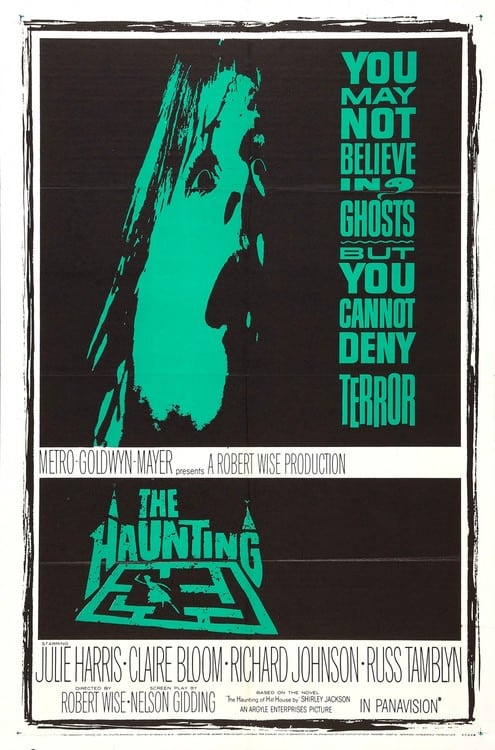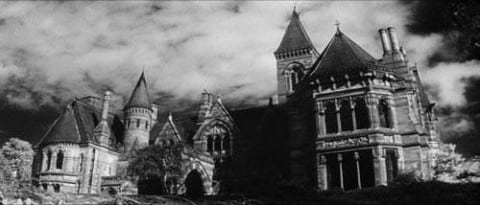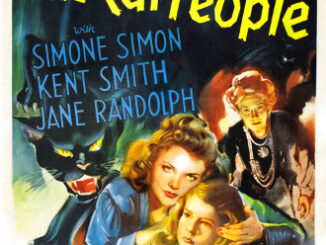The Haunting (1963)
Directed by: Robert Wise
Written by: Nelson Gidding, Shirley Jackson
Starring: Claire Bloom, Julie Harris, Richard Johnson, Russ Tamblyn
HCF REWIND NO. 258: THE HAUNTING [UK 1963]
AVAILABLE ON DVD AND BLU-RAY
RUNNING TIME: 112 min
REVIEWED BY: Dr Lenera, Official HCF Critic
Dr .John Markway is investigating paranormal activity at Hill House. It was constructed by Hugh Cain for his wife, but as she approached the house for the first time she crashed her carriage and died, as did his second wife after falling down the stairs, his daughter, crying out for her companion from the nursery she never moved out of, and the companion, who hung herself. Mrs. Sanderson inherited Hill House, but the mansion has stood empty for some time. John gets permission from Mrs. Sanderson to occupy the house, on condition that he must take Luke Sanderson, her heir, with him. He also takes with him Eleanor, who witnessed a poltergeist attack when she was young, and Theodora, a psychic….
If you love your horror and both read and talk lots about it, every now and again you’ll either read or hear someone saying that it’s what you don’t see that really scares. I guess I’m kind of in the middle – in the right hands a subtle chiller can work wonders and the mind can conjure up some terrifying things, but I do have a tendency to get impatient if the film isn’t working too well and just want to see something. The Haunting is probably the best cinematic ghost story where you don’t actually see any ghosts, and remains steadfastly true to its convictions right to the end, something many other horror films who take a similar approach tend to fail to do. Think of the final scene of the otherwise exemplary Paranormal Activity, which really cheapened and let down the whole film. People seem to be divided on whether The Haunting is really scary or not – Martin Scorsese says it’s the most frightening film ever – though for me it may just be a case of when you see it. My first two viewings were on a sunny afternoon and, while there was certainly a huge amount to appreciate such as the characterisation and ambiguities, it didn’t scare. Watched again the other night in bed, it worked a treat and I felt distinctly uneasy afterwards when I saw that my bedroom door was open.
Director Robert Wise, a maker of pretty good films in almost every genre, had served his apprenticeship under Val Lewton, the producer of a superb series of low-key horror films in the 40’s, so he was no stranger to the genre. Screenwriter Nelson Gidding’s initial adaptation of Shirley Jackson’s novel The Haunting Of Hill House [the title was changed because The House On Haunted Hill had not long come out] perceived the book to be about mental breakdown and not a ghost story at all, but rather a compilation of the insane thoughts of the lead character, Eleanor Lance, in a hospital. Elements of mental breakdown remained in the second draft, while the number of characters was cut down, the back story was significantly shortened, and most of the supernatural events depicted in the novel were kept off-screen. Shot at MGM-British Studios in the UK, the exteriors and the grounds were filmed at the supposedly haunted Ettington Hall. Numerous devices were used to make things look creepy, from infra-red film to a large wide-angle lens camera which wasn’t ready for use and therefore caused distortions. To enhance the actors’ performances during scenes in which they react to off-stage voices or sounds, Wise and his sound editors created a soundtrack of voices and noises which were played back during filming. The original cut, which has been shown and I find puzzling is not on DVD or Blu-ray, contained different opening narration and titles, a scene where the lesbian Eleanor throws her girlfriend out of their apartment, and more of Eleanor’s inner thoughts. The Haunting, surprisingly, was only a moderate commercial and critical success. It was poorly remade in 1999, while an earlier planned remake by Stephen King ended up as the TV series Rose Red in 2002. The Legend Of Hell House from 1973 can almost be classed as a semi-remake too.
The opening narration, which details the house’s death-filled past, is maybe overlong and can perhaps be seen as a little clumsy, but us knowing all this before the main action of the film begins provides an extra sense of dread and it’s all too easy for tension to evaporate when a load of exposition is given to us midway through a film or there-abouts. The sequence is enhanced immensely by odd angles, deep focus shots, rapid cutting and sometimes frantic camera movement. The latter two don’t seem like anything special when these days that’s sometimes all you see, but weren’t nearly as prevalent back in 1963. We see a carriage crash into a tree, and for a couple of seconds the camera shakes to heighten the moment, which is exactly how ‘shaky cam’ should be used. Likewise, we fall down the stairs with another victim in a dizzying manner, and I must say, though I haven’t read it elsewhere, that there seems to be a slight Psycho influence here and there, but especially when Eleanor is driving in her car and we hear her thoughts. She’s really the main character, a very insecure woman who has spent much of her life caring for her sick and, it is suggested, abusive mother, but there’s also ESP expert Eleanor, Luke the heir to the property, and a sceptic, and the Dr. who has organised this whole thing as an experiment and hand-picked the participants. He thinks that the supernatural is not evil or even scary once you get to know it.
The interiors of the house are brightly lit with few shadows, which in a way makes them creepier, and soon the bumps in the night begin. The Haunting isn’t non-stop frights – there are only three prolonged sequence of terror – and it’s mostly just sounds. The most frightening bit, and it truly is frightening watched at 1 am but it’s the one bit that got me a bit even in my previous viewings, is when horrid mumbles and whispers are heard the other side of a wall through textured wallpaper where you can almost make out faces in the distorted patterns. It’s a brilliant example of how we are given the absolute minimum for a scene and the mind just makes it so much more. The scene ends with one of the scariest lines in cinema history. “Who’s hand was I holding”? when Eleanor realises she wasn’t holding the hand of Theodora. Then there’s the door that is repeatedly bent inward, simply executed by a strong crew member pushing a piece of timber hard against the laminated wood door, though some of the eeriest moments are ones that you may only notice a second or third time, like characters exiting a room on one side, only for them to enter the next room from the same side, totally messing up the geography of the house, or both sunlight and total darkness coming in from windows at the same time. Like The Shining, The Haunting is definitely one of those films that is scarier the second or third time you see it, partly because there’s so much to notice, and I reckon that’s true whatever time of the day you see it.
Like many of the great ghost stories there’s an element of sadness, and it’s in The Haunting in spades whether you interpret the events as being real hauntings, a woman’s descent into madness, or a bit of both [the last being my preferred explanation]. Julie Harris gives one of horror cinema’s greatest performances as a woman who has been virtually shut away for years and years, tending to her ill mother, a mother who may have mistreated her, and who may have supposedly caused a rain of rocks to fall out of the sky onto a neighbour’s house. The mother dies, she’s invited to Hill House, and goes out in the world properly for perhaps the first time, certainly as an adult. She discovers that she has some burgeoning feelings for both a man and a woman but has trouble dealing with it, and in the end finds that the only thing that really wants her, and the only place where she really belongs, is the house, a house which seems alive itself [it even seems to sigh when it claims its latest victim], though, in an especially sad touch, she may still be alone at the end of the film. The Haunting is also notable for the character of Theodora, an early screen lesbian who is not predatory or mad. Actress Claire Bloom was not allowed to touch Julie Harris, but it’s still quite obvious and superbly played with looks and lines of dialogue where you have to read between the lines but it is made easy to do so. The interplay involving the characters all throughout this film is fascinating, and partly because of all the ambiguities and the fact that not everything is right on the nose as it probably would be in a similar film today.
The cinematography of Davis Boulton, employing a camera that often glides around the house and often switches to outside where the looming peaks and windows of the house really look like they make up some strange monster, and the scoring of Humphrey Searle, sometimes being your typical Crash Bang Wallop, sometimes almost becoming sound effects in a way done a lot now but which was ahead of its time back in 1963, and sometimes enhancing the film’s pathos for Eleanor, make essential contributions. In a way The Haunting’s major problem, though it’s through no fault of its own, is that its scenes and techniques [I think its influence has been hugely underrated] have been rehashed so much since it came out, and still are, that it’s lost some of its effect. It remains in the top ten of cinema’s spook tales, and I don’t think any other horror film has better shown us the idea of a house as a living, evil entity, and given us the feeling that there is a whole supernatural world, whether created in the minds of people or not, we don’t understand, partly, of course, because it doesn’t show us a damn thing.










Be the first to comment